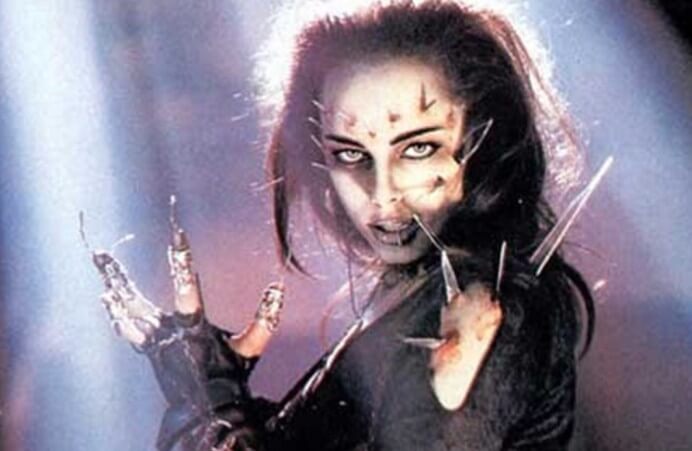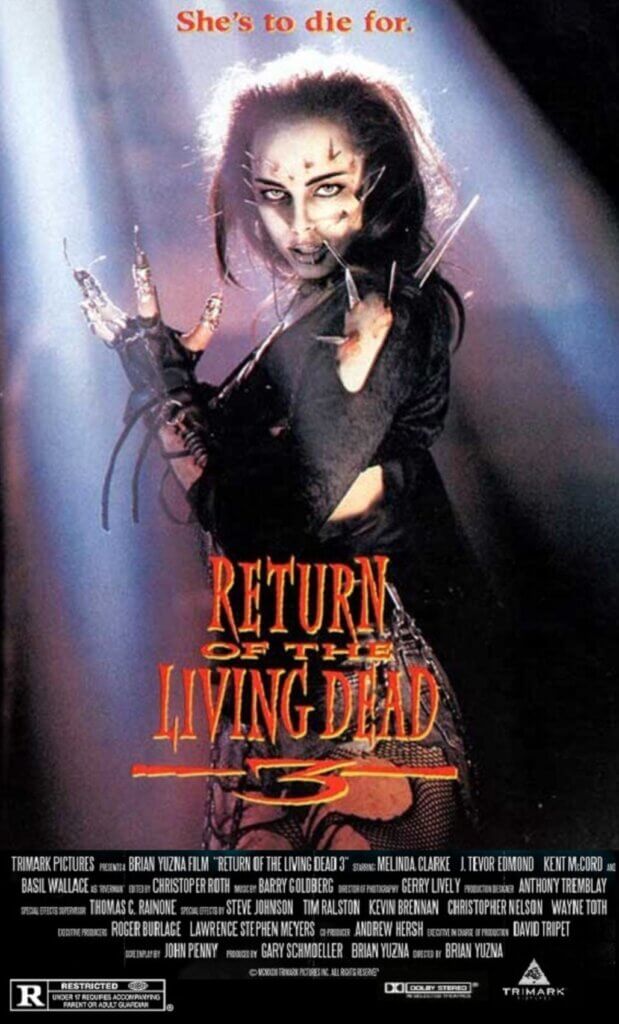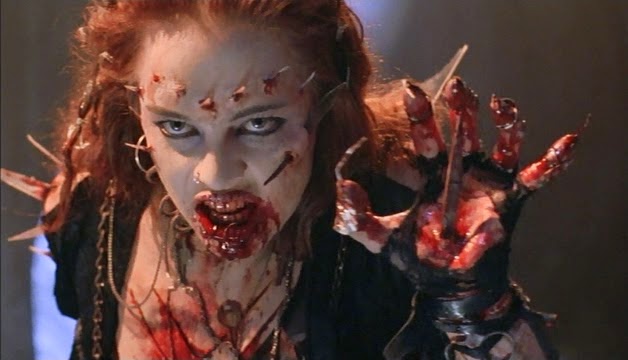Continuing a series that celebrates the fifty-fifth anniversary of Night of the Living Dead with a look at the classic zombie film and its many follow-ups.
While the mainline Night of the Living Dead sequels were consistently helmed by George A. Romero, the Return of the Living Dead sister series had no consistent auteur. The first film started as the pet project of John Russo, Rudy Ricci, and Russell Streiner before being reworked into something almost unrecognisable by writer-director Dan O’Bannon. Return of the Living Dead Part II originated as an unrelated project from a different writer-director, Ken Wiederhorn. Then, 1993 brought with it Return of the Living Dead 3, written by John Penney and directed by Brian Yuzna, the latter having previously helmed the satirical body horror film Society.
Return of the Living Dead 3 establishes that the zombie outbreaks depicted in the previous two films have been contained, with the surviving revenants housed in a military installation. Here, they are used as test subjects in an attempt to convert them into weapons of war. Teenager Curt, whose father is involved with the project, infiltrates the installation with his girlfriend Julie, and the two witness first-hand a zombie being returned to life.
Back home, Curt puts the macabre sight out of his mind to focus on other matters: namely, escaping from his domineering military dad and starting a new life in the Seattle rock scene. But his attempt to flee town ends in tragedy when Julie is killed in a motorcycle accident. Remembering what he saw in the laboratory, Curt realises that there may be a way of bringing her back…
The original Return of the Living Dead nailed the subcultural aesthetic of its punk youth but sidelined those characters in favour of older, duller characters. Return of the Living Dead 3 makes the opposite error. The story of wannabe-drummer Curt fleeing the police and military with his rapidly-zombifying girlfriend would have been just perfect for a film with the aesthetic of the first Return; yet this time the wryly comedic tone is absent.
Situations that Return 1 might have pulled off as jokes are played straight in Return 3: see Julie interrupting a sex scene with Curt to talk about the laboratory experiments they witnessed; or Curt sneaking Julie’s corpse into the compound by propping her against his back on the motorcycle; or, indeed, the solemn sincerity with which Curt describes his dream of becoming a drummer. The first film treated punk youth with cynical humour, but the cynicism meshed with the characters’ hedonism. Return 3 seems fundamentally hollow in its depiction of teenagers, getting the hairstyles and fashion right but never really engaging with Curt and Julie’s inner lives.
The supporting cast feels more like pieces of plot mechanism than believable characters. First comes a street gang that ends up pursuing the two teens for the arbitrary reason that Julie has bitten one of their crew. The two later receive aid from Riverman, a hobo who lives in the sewer and claims to have had past experience with zombies back in New Orleans (presumably of the supernatural variety). An African-American, Riverman is given the stereotyped role of handing folksy wisdom to the white leads because this is that sort of movie.
Despite all of the film’s flaws, there is one consistent virtue to the Return of the Living Dead series that remains evident here: inventive and cartoonishly over-the-top zombie designs. Early on we meet a ghoul resembling a cross between the Cryptkeeper and a pile of melted cheese, his flesh so heavily fused that he has to tear it off before he can move freely, revealing the bones below. Much later comes a zombie with a mechanical exoskeleton, the result of the military’s experiments.
And then we have the zombie Julia. In a detail likely influenced by the Hellraiser series, her transformation has a sadomasochistic element: over the course of the film, she inserts sharp objects into her dying flesh. By the end, she has become a full-on case of extreme body modification, adorned with various piercings and sporting artfully chosen patches of flayed skin. Return 1 merely flirted with this sort of punk-zombie imagery; Return 3 grabs hold of it, embraces, kisses, and fucks it.
The striking image of zombie Julia, which rightly took centre stage in the film’s publicity, is a resounding success, yet one that highlights how the film as a whole fails. Why, exactly, does Julia make such careful aesthetic decisions when committing what are supposed to be acts of desperate self-mutilation? Had the film been awash in punkish snark like the first Return, or fuelled by BDSM libido like Hellraiser, this would have been beside the point. But in the lifeless, joyless dead end that is Return of the Living Dead 3, the question becomes impossible to ignore. These zombies deserved a better film; as it is, they end up as yet more components that Return of the Living Dead 3 treats with general indifference.
A forgiving viewer might argue that the film’s general lack of enthusiasm for its subject matter is a calculated satire (director Yuzna had, after all, engaged in some pointed commentary with Society). On the one hand, Return 3 portrays contemporary teenage life as a path to destruction: Julie’s zombification process has connotations of drug addiction, while her self-harm – and, in one scene, attempted suicide – need little analysis. Yet on the other, the world of adult respectability comes across as being in no way preferable, represented by military skulduggery. There was potential here for some meaty thematic exploration, but instead, the adolescent who-cares listlessness and the middle-aged derision at today’s youth merely cancel each other out.
If nothing else, the film makes a fitting follow-up to the preadolescent-oriented Return of the Living Dead Part II. A nine-year-old who was in the ideal age group for that sequel at the time of its release would have been fourteen when Return 3 came out; this is about the right age to appreciate the film’s mixture of cartoonish gore, vague social satire, general sense of aimless rebellion, along with the sight of Julie getting topless.
But really, 1993 – the twenty-fifth anniversary of Night of the Living Dead – deserved rather more than that.
Next: A trip to the comic shop…





